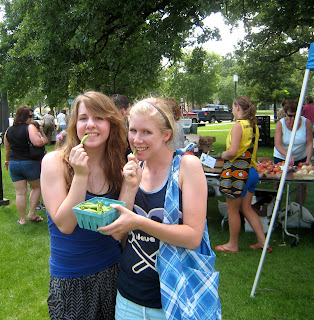
Bananas are no strangers to dessert. Banana splits are the ultimate classic while banana cream pie, bananas foster, and banana bread are favorites as well. And while these delectable desserts may please your taste buds, you heart, blood sugar, and waistline won't be so delighted by them. Now there's always a time and place for a treat; if you're at the diner go ahead and get that banana split, and if your grandma is cutting you a piece of her famous banana cream pie, I would be severely disappointed if you turned her down (as I'm sure she would be as well). But if you're just sitting around the house looking for something to appease your sweet tooth, a simple banana is a great start to a dessert that will give you your sugar fix without traumatizing any internal organs. Here are some simple and affordable banana recipes; you probably have most of the ingredients in your kitchen already.
Frozen Ripe Bananas (from the Shefveland household)
Whenever our bananas reach that too-ripe-to-eat point, we peel them and add them to the "banana bag" in our freezer. If I'm looking for a cool, refreshing treat on a hot day or am just craving some sweetness (which is a pretty frequent occurrence), I go straight for the banana bag. They taste just like banana-flavored ice cream/frozen yogurt. Give it a try!
Banana Fritters (from The Starving Student's Vegetarian Cookbook, by Dede Hall)
- 2 tbsp. flour
- 1 organic banana, sliced lengthwise into 1/4" slices
- couple shakes of cinnamon sugar
- 2 tbsp. canola oil
Instructions:
1. Spread flour on dinner plate. Lightly roll banana slices in flour.
2. Empty excess flour off plate and return bananas to plate. Sprinkle both sides of banana with cinnamon sugar until heavily coated.
3. In skillet, add oil and heat on high heat for 1 minute. Add bananas and fry on both sides until lightly browned.
4. Serve alone or topped with ice cream or frozen yogurt and sprinkled liberally with cinnamon sugar.
Frozen Chocolate-Covered Bananas (adapted from EatingWell magazine)
- 4 large organic ripe bananas
- 3/4 cup semisweet or bittersweet chocolate chips
- 1/4 cup shredded coconut or chopped nuts
Instructions
1. Line a baking sheet with parchment or wax paper.
2. Insert a popsicle stick into the cut end of each banana half.
3. Cover each piece of banana with melted chocolate using a rubber spatula and sprinkle with coconut or nuts. (Reheat chocolate, as needed, to keep it melted.)
4. Place the bananas on the baking sheet and freeze until frozen, about 2 hours.
Banana-Citrus Sorbet (from Cooking Light magazine)
- 3 ripe bananas
- 1 1/2 cups sugar
- 1/2 cup fresh lemon juice
- 2 cups water
- 1 1/2 cups fresh orange juice
Instructions
1. Place bananas in food processor; process until smooth.
2. Add sugar and lemon juice; process until well-blended.
3. Pour mixture into the freezer can of an ice-cream freezer; add water and orange juice, stirring well.
4. Freeze according to manufacturer's instructions. Spoon into freezer-safe container; cover and freeze.
Roasted Bananas with Brown Sugar-Walnut Glaze (from Cooking Light magazine)
-1/3 cup packed brown sugar
- 1/4 cup fresh lemon juice
- 2 tbsp butter, melted
- 1/4 tsp ground cinnamon
- 4 large organic firm ripe bananas (about 1 1/2 pounds)
- Cooking spray
- 1/4 cup chopped walnuts, toasted
- 1 1/2 cups vanilla frozen yogurt
Instructions:
1. Preheat oven to 450°.
2.Combine first 4 ingredients in a bowl, and set aside.
3. Cut bananas in half lengthwise. Place banana halves, cut sides up, on a jelly-roll pan coated with cooking spray.
4. Bake at 450° for 4 minutes.
5. Drizzle sugar mixture evenly over banana halves, and sprinkle with toasted walnuts.
6. Bake an additional 3 minutes.
7. Cut each banana piece into thirds crosswise.
8. Serve bananas with frozen yogurt; drizzle with any remaining sugar mixture.
Banana Mousse (from YumSugar.com)
- 2 tablespoons milk
- 4 tsp sugar
- 1 tsp vanilla
- 1 medium organic banana, cut in quarters
- 1 cup plain yogurt
- 8 1/4-inch banana slices
Instructions
1. Place milk, sugar, vanilla, and banana in blender. Process 15 seconds at high speed until smooth.
2. Pour mixture into a small bowl; fold in yogurt.
3. Chill.
4. Spoon into 4 dessert dishes; garnish each with 2 banana slices just before serving.
Photo Credits: Ian Ransley Design + Illustration,
ginnerobot



































